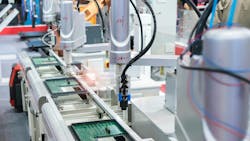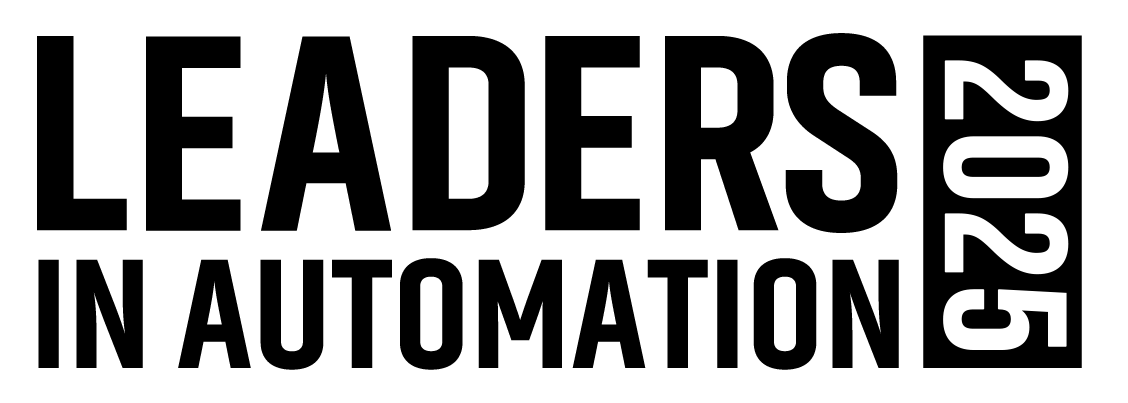- Enabling direct system coordination without centralized bottlenecks allows robots, conveyor systems and equipment to interpret data, make decisions and adapt together as an integrated manufacturing ecosystem.
- Without consistent sensor outputs and machine logs across production lines, each new AI implementation requires starting from scratch, turning what should be scalable solutions into costly custom rebuilds for every location.
- Manufacturers can scale AI by selecting bounded use cases with clear ROI, standardizing data from the start, ensuring IT/OT collaboration and building systems that learn from variability rather than relying on fixed parameters.
Manufacturers are under growing pressure to prove that artificial intelligence can deliver results.
On a modern assembly line, testing a smartphone’s touchscreen seems almost too simple to automate. A human operator starts the device, taps every part of the screen, pinches to zoom and confirms it responds. The process is so intuitive that you could teach it to almost anyone in minutes.
Training a robot to do this becomes easier to do almost every year, but can still require configuring dimensions, specifying every test point and programming the robot’s exact movements. However, if the phone’s size or layout changes, engineers have to start over. That’s why this approach can work in highly repetitive environments, but it can’t adapt or scale easily.
But this scenario is changing with AI. Using cameras and AI models that can learn from what they see, robots can identify a phone or tablet placed before them, measure its dimensions, recognize if it’s upside-down, create a grid of touch points and run the full test — all without a reprogramming cycle.
Models should be capable of learning from variability rather than relying on rigid parameters, allowing them to adapt to new products or formats.
This is a striking leap from the rigid, single-purpose automation of the past to adaptive, self-learning systems that can handle variation.
For the manufacturing industry, getting up to speed with these changes can be challenging. While some organizations are integrating adaptive robotics, IoT data and AI analytics into production, others remain stuck with limited pilots that never expand beyond one line or site.
The reality is that most manufacturers fall somewhere in between, navigating a mix of legacy systems, uneven data quality and organizational silos that complicate progress.
A proof-of-concept, like a self-learning tester, might work flawlessly in one facility. But scaling it across plants, or even across multiple lines in the same plant, often exposes the cracks. These cracks include data siloed between production cells, IT and operations teams working in parallel rather than in sync, and lack of standardization with sensor outputs and machine logs. Disconnects such as these force every new deployment to start from scratch.
AI pilots that look great in a case study stall before they deliver plant-wide value. The technology isn’t the problem. The real barrier lies in the complex, interconnected ecosystem of manufacturing data and the organizational gaps that prevent it from being used consistently.
The result is a common pattern: AI pilots that look great in a case study stall before they deliver plant-wide value. The technology isn’t the problem. The real barrier lies in the complex, interconnected ecosystem of manufacturing data and the organizational gaps that prevent it from being used consistently.
Overcoming those barriers is the difference between an AI pilot that fades out and one that transforms how an entire business runs.
Why AI stalls in manufacturing
Two issues rise to the top when manufacturing AI efforts stall: fragmented data and a disconnect between operational technology (OT) and information technology (IT).
Fragmented data shows up in many forms. Assembly lines may collect different sensor readings from the same process. Machines from different vendors log information in incompatible formats. Historical data needed to train AI models may be incomplete or stored in locations inaccessible to the AI system. Without consistent, connected data, scaling beyond the pilot phase becomes an exercise in reengineering the solution for each new environment.
Then there’s the IT/OT gap. For example, a warehouse may invest in robotics to sort products dynamically, but if those robots can’t easily integrate with the warehouse management system or share data in a usable format, scaling beyond one site is difficult.
Recent advances show the potential and complexity of scaling AI in manufacturing. In warehouses, swarms of robots now move goods from receiving to storage with minimal human intervention, guided by vision systems that can recognize barcodes from any angle in less than a second. In automotive plants, small autonomous robots can lift and park finished vehicles without a driver, freeing workers for higher-value tasks. In pharmaceutical manufacturing, IoT agitation pumps adjust processes in real time based on sensor readings, with commands sent directly from cloud-based systems.
Using cameras and AI models that can learn from what they see, robots can identify a phone or tablet placed before them, measure its dimensions, recognize if it’s upside-down, create a grid of touch points and run the full test — all without a reprogramming cycle.
Success comes from connecting the mechanical and the digital so that robots, conveyor systems and pumps become linked to systems that can interpret data, make decisions and adapt.
A roadmap for moving beyond pilots
Scaling AI in manufacturing starts with pilots built for repeatability, not just proof-of-concept wins. That means selecting well-bounded use cases with clear ROI — like automating a single inspection process or optimizing one production step across plants — and ensuring the supporting data is standardized so models can be applied across environments without major rework.
It also requires close collaboration between OT and IT from the outset, with both sides defining requirements, success metrics, and integration points together. Models should be capable of learning from variability rather than relying on rigid parameters, allowing them to adapt to new products or formats. Finally, enabling machine-to-machine communication helps systems coordinate directly, avoiding bottlenecks from overreliance on centralized control.
By tackling data fragmentation and bridging the IT/OT divide early, manufacturers can set AI projects on a path to scale. The goal is to build adaptive systems that work reliably across sites, lines and products.
When AI systems learn and adapt alongside the people and processes they support, they stop being projects and start becoming part of how work gets done.
On that smartphone line, the real breakthrough isn’t just that a robot can test any screen — it’s that the capability becomes a dependable part of production everywhere, no matter the product or plant. That’s when AI-driven automation stops being an experiment and starts delivering value shift after shift.
Lakshmi Duvoor is head of U.S. central business unit at Altimetrik.


